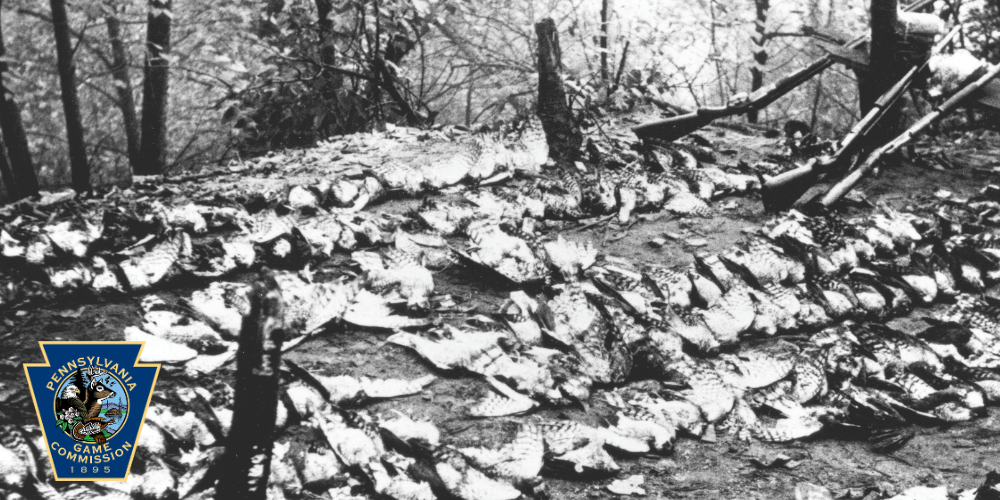
Pennsylvania has a rich and storied conservation history. From bald eagle and elk reintroductions to the creation and management of wildlife habitat on more than 1.6 million acres of public land, the Pennsylvania Game Commission has had many successes in its nearly 130-year existence. However, it has not aways been sunshine and rainbows. Read on to learn how the Game Commission went from implementing bounties on birds of prey to purchasing land for the sole purpose of raptor conservation.
Bad Reputations and Bounties
Raptors were regarded as “vermin” and unprotected in Pennsylvania throughout the eighteenth and nineteenth centuries. Animosity towards birds of prey existed because they killed poultry and game birds coveted by farmers and hunters alike. Persecution of raptors increased substantially when bounties were placed on all diurnal birds of prey and owls. In 1929, a $5 bounty on goshawks and great horned owls was an attractive sum during the Great Depression. Several places along the Kittatinny Ridge, including Hawk Mountain, were infamous hawk slaughtering grounds. Amid growing calls for an end to bird of prey bounties from legislators and hunters resistant to change, the Game Commission aimed to keep the peace by releasing information on differentiating between “good” (i.e. rodent-eating) and “bad” (i.e. bird-eating) hawks: “Remember the good hawks have short tails and long wings and soar much like a turkey vulture, and that the bad hawks have comparatively short wings and long tails and beat their tails rapidly, often holding themselves in mid-air for a moment before diving for their prey. The bad hawks constitute the goshawk, Cooper’s hawk, and sharp-shinned hawk” (Kosak 1995).
Shifting Tides
A bright spot in raptor conservation came in 1934 in the form of Rosalie Edge. An environmentalist from New York City, Edge leased the land that was to become Hawk Mountain Sanctuary, the world’s first refuge focused on raptor protection and conservation. Despite a 1937 law protecting all diurnal birds of prey (aside from the three bird-eating raptors, great horned owls, and snowy owls), unpopularity among hunters and farmers, coupled with scant enforcement, led to birds being killed well into the 1960s. However, 35 years of conservation and education efforts at Hawk Mountain started to take root. Statewide, year-round protection for all diurnal birds of prey, including the three bird-killing accipiters, came in 1969, with great horned owls and snowy owls coming into protection following an amendment to the Migratory Bird Treaty Act in 1972.
Changing Threats
As industrialization and development rapidly occurred after World War II, raptor populations faced new hazards in the form of pesticides and habitat loss. Bald eagle and osprey populations were experiencing drastic declines; however, the banning of DDT and passage of the Endangered Species Act in 1972 offered hope for a better future. A successful osprey reintroduction project occurred in the Poconos, with the first nesting pair since 1910 recorded in 1985 and more than 100 ospreys hacked by the late 80s. In 1983, the Game Commission began its efforts to bring bald eagles back from the brink of extirpation. During the seven-year program, Game Commission staff brought 91 eaglets from Saskatchewan, Canada to Pennsylvania. The young birds were placed in hacking towers with makeshift nests for 6-8 weeks, then released around 12-14 weeks. Eighty-eight of 91 birds were successfully released, and in 1988, an eagle nest was found in Tioga County, believed to be the first established nest in eastern PA in decades. Raptor populations continued to increase substantially the last two decades of the 20th century.
Better Days
Today, all birds of prey remain officially protected, fairly common, and fully functional components of their natural landscapes, especially along the Kittatinny Ridge. Hawk Mountain, once a shooting gallery where thousands of raptors were killed, now serves as a hub of outdoor recreation, education, and biological research, receiving tens of thousands of visitors annually. The Pennsylvania Game Commission, once the enforcer of bounties on raptors, now owns Waggoner’s Gap Hawk Watch, which encompasses over 130 acres of non-huntable land dedicated to raptor research and conservation. The agency has a robust American kestrel and barn owl conservation program to monitor, band, and install nest boxes across the state. In 2014 and 2021, bald eagles and peregrine falcons were removed from the state threatened list, respectively. Game Commission staff, from biologists to land managers to educators, work hard to keep our common raptors common. Conservation education for school children to the general public, long-term monitoring programs, and wildlife viewing opportunities at hawk watches, especially during migration season, are all practical, effective, and critical ways to build continued support for raptor conservation in Pennsylvania.
Reference:
Kosak, J. 1995. The Pennsylvania Game Commissions 1895-1995. Pennsylvania Game Commission, Harrisburg, PA.